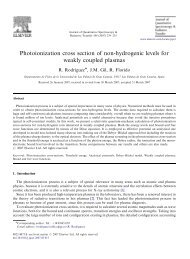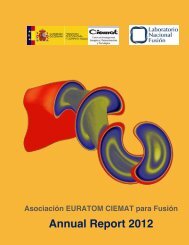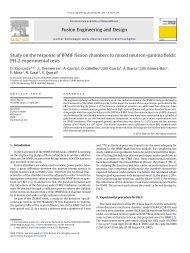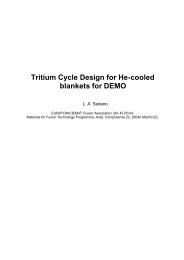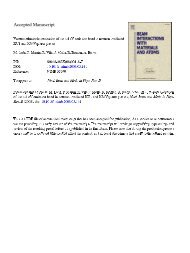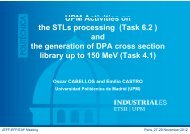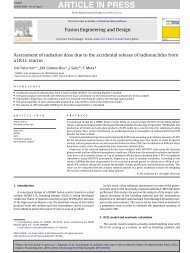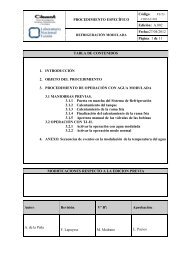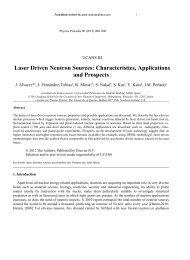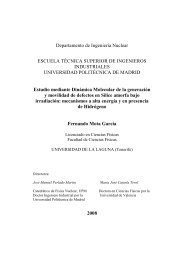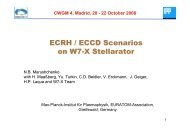Processing and validation of JEFF3.1 library in ACE format ... - Ciemat
Processing and validation of JEFF3.1 library in ACE format ... - Ciemat
Processing and validation of JEFF3.1 library in ACE format ... - Ciemat
You also want an ePaper? Increase the reach of your titles
YUMPU automatically turns print PDFs into web optimized ePapers that Google loves.
International Conference on Nuclear Data for Science <strong>and</strong> Technology 2007<br />
DOI:225<br />
<strong>Process<strong>in</strong>g</strong> <strong>and</strong> <strong>validation</strong> <strong>of</strong> <strong>JEFF3.1</strong> <strong>library</strong> <strong>in</strong> <strong>ACE</strong> <strong>format</strong><br />
at 10 different temperatures<br />
O. Cabellos 1,a, , Y. Rugama 2<br />
1 Instituto de Fusion Nuclear, UPM, Spa<strong>in</strong><br />
2<br />
OECD/NEA, 92130 Issy-les-Moul<strong>in</strong>eaux, France<br />
Abstract. In July 2006 the NEA/Data Bank made available upon request the JEFF-3.1 <strong>library</strong> <strong>in</strong> <strong>ACE</strong> <strong>format</strong><br />
(NEA-1768 ZZ-MC<strong>JEFF3.1</strong>NEA). This <strong>library</strong> conta<strong>in</strong>s cont<strong>in</strong>uous energy neutron cross-section data files for use<br />
<strong>in</strong> the Monte Carlo program MCNP. The nuclides processed are all the evaluations <strong>of</strong> the General Purpose Library<br />
<strong>and</strong> Thermal Scatter<strong>in</strong>g JEFF-3.1 Library, <strong>in</strong>clud<strong>in</strong>g the important light nuclei, structural materials, fission<br />
products, control rod materials <strong>and</strong> burnable poisons, all major <strong>and</strong> m<strong>in</strong>or act<strong>in</strong>ides. This <strong>library</strong> was generated with<br />
the NJOY-99.90 nuclear data process<strong>in</strong>g system plus some specific updates required for correct process<strong>in</strong>g. The<br />
<strong>library</strong> has undergone strict Q&A procedures. All <strong>in</strong>puts used for process<strong>in</strong>g <strong>JEFF3.1</strong> with NJOY99.90 <strong>and</strong> the<br />
documented derived version are provided. The <strong>validation</strong>s made, us<strong>in</strong>g benchmark experiments for criticality<br />
(ICSBEP) <strong>and</strong> shield<strong>in</strong>g (SINBAD) are documented <strong>in</strong> the report.<br />
1 Introduction<br />
The evaluated nuclear data <strong>library</strong> JEFF-3.1 [1] was released<br />
<strong>in</strong> May 2005. The neutron General Purpose <strong>library</strong> conta<strong>in</strong>s<br />
<strong>in</strong>cident neutron data for 381 materials from 1 H to 255 Fm<br />
(isotopes <strong>in</strong> isomeric state 58M Co, 110M Ag, 115M Cd, 127M Te,<br />
129M Te, 148M Pm, 242M Am, 244M Am) <strong>and</strong> the Scatter<strong>in</strong>g Thermal<br />
<strong>library</strong> (STL) covers 9 materials.<br />
The code system used for the process<strong>in</strong>g was NJOY99 [2]<br />
<strong>and</strong>, <strong>in</strong> particular, the <strong>ACE</strong>R module. For the correct<br />
process<strong>in</strong>g <strong>of</strong> the <strong>JEFF3.1</strong> <strong>library</strong>, various patches to the<br />
code NJOY99.90 are needed. The patches have been<br />
provided by several authors <strong>and</strong> are supplied together with<br />
the <strong>library</strong> <strong>and</strong> its documentation. All <strong>in</strong>puts used for<br />
process<strong>in</strong>g <strong>and</strong> the documented derived version are provided<br />
<strong>in</strong> NEA-1768.<br />
In order to cover a large number <strong>of</strong> applications, the <strong>library</strong><br />
has been processed at a wide range <strong>of</strong> temperatures: 300,<br />
400, 500, 600, 700, 800, 900, 1000, 1200 <strong>and</strong> 1800 Kelv<strong>in</strong><br />
degrees (the NEA package is separated as separate entity for<br />
each temperature to facilitate h<strong>and</strong>l<strong>in</strong>g). The <strong>library</strong> at 300K<br />
has been verified: visually (no discont<strong>in</strong>uities, correct<br />
process<strong>in</strong>g <strong>in</strong> all range) <strong>and</strong> by comparison with other<br />
libraries available for the same purposes (ENDF/B-VI.8,<br />
JEF2.2, JENDL3.3. . .). A Quality Assurance procedure has<br />
been also established to ensure the quality <strong>of</strong> the processed<br />
file.<br />
Various criticality <strong>and</strong> shield<strong>in</strong>g benchmarks (International<br />
H<strong>and</strong>book <strong>of</strong> Evaluated Criticality Safety Benchmark<br />
Experiments from the OECD-NEA project (ICSBEP) [3],<br />
Shield<strong>in</strong>g Integral Benchmark <strong>and</strong> Database (SINBAD) [4])<br />
have been performed to validate the processed <strong>library</strong>.<br />
Results from the Quality Assurance procedure used are<br />
documented <strong>in</strong> a complete report distributed together with<br />
the files.<br />
2 <strong>Process<strong>in</strong>g</strong> evaluated nuclear data to <strong>ACE</strong><br />
<strong>format</strong><br />
NJOY is a modular computer code used for convert<strong>in</strong>g<br />
evaluated nuclear data <strong>in</strong> the ENDF <strong>format</strong> <strong>in</strong>to different<br />
type <strong>of</strong> libraries useful for criticality <strong>and</strong> shield<strong>in</strong>g<br />
applications. The JEFF-3.1 evaluated nuclear data file has<br />
been processed us<strong>in</strong>g NJOY-99.90 with some additional<br />
updates. The patch up90 was not able to process the whole<br />
JEFF-3.1 <strong>library</strong>.<br />
The process<strong>in</strong>g sequence for generat<strong>in</strong>g <strong>ACE</strong>-<strong>format</strong>ted<br />
<strong>library</strong> suitable for use by the MCNP [5] code is shown<br />
below <strong>in</strong> fig. 1.<br />
MODER<br />
RECONRR<br />
PURR<br />
BROADR<br />
HEATR<br />
GASPR<br />
THERMR<br />
<strong>ACE</strong>R<br />
(create <strong>ACE</strong> file)<br />
<strong>ACE</strong>R<br />
(check <strong>ACE</strong> file)<br />
Fig. 1. NJOY process<strong>in</strong>g sequence for <strong>ACE</strong>-<strong>format</strong> neutron <strong>library</strong>.<br />
The <strong>library</strong> conta<strong>in</strong>s cont<strong>in</strong>uous energy neutron cross section<br />
data files for use <strong>in</strong> the Monte Carlo code MCNP. Also,<br />
Probability Tables (PT) have been generated for those<br />
a Present<strong>in</strong>g author, e-mail: cabellos@d<strong>in</strong>.upm.es
2 International Conference on Nuclear Data for Science <strong>and</strong> Technology 2007<br />
materials conta<strong>in</strong><strong>in</strong>g unresolved resonance data. In addition,<br />
several STLs have been processed for [6]: Hydrogen bound<br />
<strong>in</strong> polyethylene, water <strong>and</strong> ZrH; Graphite, D bound <strong>in</strong> D2O,<br />
Be <strong>and</strong> Be <strong>in</strong> BeO.<br />
3 Quality Assurance procedure<br />
We have performed a Q&A procedure for each nuclide <strong>of</strong><br />
the <strong>JEFF3.1</strong> <strong>library</strong> processed.<br />
3.1 Check<strong>in</strong>g NJOY output messages for<br />
each nuclide<br />
The total number <strong>of</strong> messages from the NJOY process<strong>in</strong>g<br />
were compiled. All messages were understood, most <strong>of</strong> them<br />
were related to <strong>in</strong>complete evaluations [7]. The reason to run<br />
the <strong>ACE</strong>R module twice is to evaluate the consistency <strong>of</strong> the<br />
<strong>ACE</strong> <strong>format</strong>, we checked <strong>and</strong> corrected problems that might<br />
be detected with the second run. However, <strong>ACE</strong>R does not<br />
<strong>in</strong>clude the capability to check the proper process<strong>in</strong>g <strong>of</strong> the<br />
unresolved resonance probability tables [8, 9]. The PT<br />
method was implemented <strong>in</strong> MCNP to account statistically<br />
for the average resonance parameters specified <strong>in</strong> the<br />
unresolved resonance range. In PT method, the average<br />
parameters are used to generate ladders <strong>of</strong> representative<br />
resonances. Cross sections from these ladders are then used<br />
to create cross-section probability distribution functions,<br />
from which a cross sections table (total, elastic, fission, <strong>and</strong><br />
radiative capture) is prepared as function <strong>of</strong> probability.<br />
Orig<strong>in</strong>ally, evaluators decided to drop plans to <strong>in</strong>clude data<br />
for any isotope with a large number <strong>of</strong> negative cross<br />
sections <strong>in</strong> the PT data. The problems were traced to negative<br />
background cross sections <strong>in</strong> ENDF libraries [10]. So the<br />
negative cross section problems <strong>in</strong> the PT are related with the<br />
evaluation <strong>and</strong> it is not a problem with the PURR module <strong>of</strong><br />
NJOY (the method <strong>of</strong> calculat<strong>in</strong>g the probability table as<br />
implemented <strong>in</strong> NJOY should not lead negative values by<br />
itself [11])<br />
To summarize, there are a number <strong>of</strong> possible problems or<br />
abnormalities with the PTs that can be directly noticed for<br />
some isotopes. Three different situations with three<br />
approaches were <strong>in</strong>vestigated: i) Probability b<strong>in</strong>s with a<br />
probability <strong>of</strong> 0, these b<strong>in</strong>s will not be sampled so it can be<br />
accepted; ii) zero cross section values (either for the entire<br />
b<strong>in</strong> or for specific reactions), can occur either <strong>in</strong> the lower<br />
b<strong>in</strong>s because the cross section becomes very small or when<br />
the particular row has a fractional probability <strong>of</strong> zero (<strong>in</strong> this<br />
case, the row will never be sampled) so zero cross section<br />
can be allowed; <strong>and</strong> iii) negative cross section values that<br />
cannot be allowed (<strong>and</strong> the <strong>library</strong> file has to be recalculated<br />
without probability tables), unless they appear <strong>in</strong> a row with<br />
zero fractional probability (<strong>in</strong> which case the PTs will not be<br />
used).<br />
The procedure <strong>in</strong> this work has been to simply omit the PT<br />
from <strong>ACE</strong> file whenever negative values are found. The list<br />
<strong>of</strong> isotopes that had negative PT values is listed as follows:<br />
22 Na, 36 Ar, 101 Ru, 104,106,107,108,110 Pd, 109 Ag, 139 La, 141 Pr, 147 Pm,<br />
144,145,146,148 Nd, 238 Np, 252 Cf, 253 Es.<br />
3.2 Q&A with <strong>ACE</strong>LST code<br />
Here, we have ma<strong>in</strong>ta<strong>in</strong>ed that “the human eye will be used<br />
as a wonderfully complex tool, able to spot <strong>in</strong>consistency <strong>and</strong><br />
error with amaz<strong>in</strong>g precision” [11]: Look<strong>in</strong>g for unexpected<br />
discont<strong>in</strong>uities <strong>in</strong> cross sections, exam<strong>in</strong>e secondary<br />
distributions, threshold regions <strong>and</strong> resonance regions.<br />
We have applied the Q&A procedure developed <strong>in</strong> ref. [12].<br />
For check<strong>in</strong>g the contents <strong>of</strong> all the <strong>ACE</strong>-<strong>format</strong>ted files, we<br />
have converted back to ENDF6 <strong>format</strong> us<strong>in</strong>g the code<br />
<strong>ACE</strong>LST [13] These ENDF6 files were compared with the<br />
orig<strong>in</strong>al evaluation us<strong>in</strong>g both NJOY <strong>and</strong> PREPRO-2004<br />
code [14] system (LINEAR + RECENT + SIGMA1).<br />
Warn<strong>in</strong>gs <strong>and</strong> messages from PREPRO-2004 codes are<br />
useful to complete an additional check.<br />
We can conclude that the processed data were judged to be<br />
acceptable. However, some differences between NJOY <strong>and</strong><br />
PREPRO-2004 should be <strong>in</strong>vestigated: Tl-nat capture cross<br />
section (<strong>in</strong>consistency found at low neutron thermal energy<br />
due to the type <strong>of</strong> <strong>in</strong>terpolation law used at low energy), the<br />
total cross sections (NJOY calculates the total cross section<br />
summ<strong>in</strong>g the partial cross sections <strong>and</strong> PREPRO-2004<br />
processes directly the total cross section) <strong>and</strong> different<br />
resonance treatment. Also <strong>in</strong>consistency data for<br />
58 Co<br />
resonance capture cross section was found <strong>in</strong> JEFF-3.1.<br />
4 NJOY updates to process <strong>ACE</strong> <strong>library</strong><br />
Several Research Centres have developed specific<br />
NJOY99.90 updates to be used <strong>in</strong> nuclear data process<strong>in</strong>g.<br />
An <strong>in</strong>tensive work has been performed to compile the most<br />
recent NJOY updates to process the JEFF-3.1 <strong>library</strong>.<br />
Firstly, the follow<strong>in</strong>g patches were compiled for the correct<br />
process<strong>in</strong>g <strong>of</strong> the full file: D. Leichtle, I. Schmuck (FZK) to<br />
correctly process 9 Be(n,2n), D. L. Aldama (NDS/IAEA)<br />
patch <strong>in</strong>cluded <strong>in</strong> the IAEA/ADS-lib/V1.0, A. Hogenbirk<br />
(NRG) for <strong>ACE</strong>R-process<strong>in</strong>g <strong>of</strong> delayed neutron data after<br />
the extension <strong>in</strong> <strong>JEFF3.1</strong> to 8 groups, M. Mattes (IKE) for<br />
thermal scatter<strong>in</strong>g cross sections. Other updates have been<br />
provided by O. Cabellos (NEA Data Bank), M. Pescar<strong>in</strong>i<br />
(ENEA), Kazuaki Kosako (Shimizu Corporation), J.C.<br />
Sublet (CEA), A.Trkov (IAEA) IAEA-FENDL <strong>and</strong> WLUP.<br />
We have collected these updates, <strong>and</strong> we have obta<strong>in</strong>ed a<br />
unique update to be used <strong>in</strong> this work. To reach this objective<br />
an extensive work has been performed: check<strong>in</strong>g consistency<br />
between different updates <strong>and</strong> correct<strong>in</strong>g small mistakes.<br />
F<strong>in</strong>ally, a comparison with the most recent NJOY updates<br />
[15] shown that most <strong>of</strong> the previous updates were <strong>in</strong>cluded<br />
except for the delayed neutron, the 9 Be (n,2n) reaction <strong>and</strong><br />
some specific updates for JEFF-3.1.<br />
5 Validation<br />
5.1 Criticality Validation<br />
An extensive criticality <strong>validation</strong> suite could be used by the<br />
International H<strong>and</strong>book <strong>of</strong> Evaluated Criticality Safety
M. Smith <strong>and</strong> V. Dur<strong>and</strong> : Title <strong>of</strong> the article (or a short title if necessary) (Times 9pt)<br />
3<br />
Benchmark Experiments from the OECD-NEA project<br />
(ICSBEP) [3]. Two suites <strong>of</strong> calculations to assess the<br />
reactivity impact <strong>of</strong> changes to associated nuclear data<br />
libraries taken from ICSBEP were performed: i) a <strong>validation</strong><br />
suite proposed <strong>in</strong> ref. [16], ii) <strong>and</strong> an additional <strong>validation</strong>,<br />
also <strong>in</strong>cluded <strong>in</strong> ICSBEP for: Np237, heavy-Water solutions,<br />
very thermal Pu solution, unmoderated ZEUS benchmark.<br />
Other references have been used to compare these<br />
calculations [9, 17]. Tab. 1 summarizes the cases <strong>in</strong> the<br />
criticality <strong>validation</strong> suite.<br />
Table 1. MCNP Criticality Validation Suite.<br />
Description Benchmark<br />
ENDF/B-VII NEA<br />
R.D.Mosteller [16] JEFF-3.1<br />
Jezebel 1.00000 (200) 0.99980 (30) 1.00038 (26)<br />
Jezebel-240 1.00000 (200) 1.00030 (30) 1.00337 (27)<br />
Fast<br />
Pu Buttons 1.00000 (300) 099840 (30) 0.99698 (30)<br />
Flattop-Pu 1.00000 (300) 1.00040 (30) 1.00277 (31)<br />
PU<br />
THOR 1.00000 (60) 1.00790 (30) 1.00271 (27)<br />
Pu-MF-11 1.00000 (100) 0.99920 (40) 0.99722 (34)<br />
Interm HISS/HPG 1.00000 (1100) 1.01060 (20) 1.00654 (42)<br />
PNL-33 1.00240 (210) 1.00630 (30) -<br />
Thermal PNL-2 1.00000 (650) 1.00290 (50) 1.00504 (43)<br />
PU-SOL-THERM-009 1.00030 (330) 1.01910 (20) 1.01515 (49)<br />
Jezebel-233 1.00000 (100) 0.99970 (30) 1.00379 (24)<br />
Fast Flattop-23 1.00000 (140) 0.99940 (30) 1.00612 (30)<br />
U233<br />
U233-MF-05_case2 1.00000 (300) 0.99790 (30) 1.00010 (30)<br />
Interm Falstaff_case1 1.00000 (830) 0.99050 (50) 0.98416 (48)<br />
Therm<br />
SB_2.5 1.00000 (240) 0.99880 (40) 0.99700 (44)<br />
ORNL-11 1.00060 (290) 1.00410 (20) 0.99723 (17)<br />
Godiva 1.00000 (100) 0.99940 (30) 0.99696 (27)<br />
T<strong>in</strong>kertoy-2 1.00000 (380) 1.00040 (30) -<br />
Fast Flattop-25 1.00000 (300) 1.00290 (30) 1.00220 (28)<br />
Godiver 0.99850 (110) 0.99780 (40) 0.99444 (32)<br />
HEU-MET-FAST-73 1.00120 (150) 1.00800 (30) 1.00849 (26)<br />
HEU<br />
Zeus-2 1.00010 (80) 0.99580 (40) 0.99490 (35)<br />
Intermediate UH3 1.00000 (470) 0.99520 (40) -<br />
SB-5 1.00150 (280) 0.99570 (50) 0.99797 (50)<br />
Thermal ORNL-10 1.00150 (260) 0.99890 (20) 0.99874 (17)<br />
HEU-SOL-THERM4_c1 1.00000 (330) 0.98390 (40) 0.98438 (38)<br />
IEU-MF-03 1.00000 (170) 1.00270 (30) 0.99897 (27)<br />
Fast BIG-TEN 0.99480 (130) 0.99520 (20) 0.99774 (23)<br />
IEU<br />
IEU-MF-04 1.00000 (300) 1.00720 (30) 1.00379 (28)<br />
Intermediate Zebra-8H 1.03000 (250) 1.01980 (20) 1.01579 (23)<br />
Thermal<br />
IEU-CT-02_c3 1.00170 (440) 1.00080 (30) 1.00081 (33)<br />
STACY-36 0.99880 (130) 0.99940 (30) 0.99860 (20)<br />
LEU Thermal<br />
BaW XI_2 1.00070 (120) 1.00000 (30) 0.99984 (30)<br />
LEU-ST-02_c2 1.00240 (370) 0.99610 (30) 0.99630 (28)<br />
SPEC Thermal SPEC-MET-FAST-08 1.00190 (360) 0.99240 (30) 0.99177 (24)<br />
* Cases with differences more than 2*σ are marked <strong>in</strong> red.<br />
The MCNP calculations were run with 5.000.000 active<br />
neutron histories for all but two cases <strong>in</strong> the suite (550<br />
generations with 10.000 neutrons per generation, exclud<strong>in</strong>g<br />
the first 50 generations from the statistics). Only 3.000.000<br />
active histories were used for those cases, SB-5 <strong>and</strong> Zebra-<br />
8H, because they require substantially more computer time<br />
per history than the other cases (350 generations).<br />
Nonetheless, the st<strong>and</strong>ard deviation for keff from those cases<br />
is comparable to those for other cases <strong>in</strong> the suite. This<br />
number <strong>of</strong> histories is sufficient to render the statistical<br />
uncerta<strong>in</strong>ty from the MCNP calculations essentially<br />
negligible relative to the benchmark uncerta<strong>in</strong>ty for most <strong>of</strong><br />
the cases <strong>in</strong> the suite. This suite can provide a general<br />
<strong>in</strong>dication <strong>of</strong> the overall performance <strong>of</strong> a nuclear data<br />
<strong>library</strong>, <strong>and</strong> is not an absolute <strong>in</strong>dicator <strong>of</strong> the accuracy or<br />
reliability <strong>of</strong> a given nuclear data <strong>library</strong>.<br />
In conclusion, we identify: i) deficiencies <strong>in</strong> fast cases (Pu,<br />
U233, HEU <strong>and</strong> IEU) <strong>and</strong> <strong>in</strong>termediate cases (HEU <strong>and</strong>
4 International Conference on Nuclear Data for Science <strong>and</strong> Technology 2007<br />
IEU), ii) cross sections for Pu239 should be re-exam<strong>in</strong>ed <strong>in</strong><br />
the deep thermal range (PU-SOL-THERM-009), iii) fast<br />
cross sections for Cu should be reviewed (HEU-MET-FAST-<br />
73), iv) fast cross sections for Np-237 should be reviewed<br />
(SPEC-MET-FAST-08). Improvements for IEU-MF-03<br />
(bare) <strong>and</strong> IEU-MF-04 (light reflector) <strong>and</strong> good<br />
approximation for LEU are shown.<br />
5.2 Radiation-Shield<strong>in</strong>g <strong>validation</strong> Suite<br />
A shield<strong>in</strong>g <strong>validation</strong> suite taken from SINBAD Database<br />
[4] was used. Other references have been used to compare<br />
these calculations [9, 18]:<br />
i) Ispra Iron Benchmark Experiment (study <strong>of</strong> the neutron<br />
deep penetration <strong>in</strong> homogeneous materials commonly used<br />
<strong>in</strong> the construction <strong>of</strong> advanced reactors), ii) KANT<br />
Spherical Shell Transmission Experiment on Beryllium, see<br />
fig. 2 (to clarify the discrepancies <strong>in</strong> the effective neutron<br />
multiplication <strong>of</strong> bulk beryllium assemblies with central 14<br />
MeV neutron sources), iii) NIST (a Cf source was placed at<br />
the centre <strong>of</strong> the experiment, <strong>and</strong> fission foils were placed at<br />
two, diametrically opposed positions, between the source <strong>and</strong><br />
the fission foils were several comb<strong>in</strong>ations <strong>of</strong> shield<strong>in</strong>g<br />
materials, iv) IPPE (neutron transmission benchmark<br />
experiment with 14 MeV neutrons through iron shells), v)<br />
FNS (neutron spectrum emerg<strong>in</strong>g from slabs <strong>of</strong> material <strong>of</strong><br />
vary<strong>in</strong>g thickness from a 14 MeV D-T neutron source), vi)<br />
Oktavian (leakage current spectrum from the outer surface <strong>of</strong><br />
a spherical pile <strong>of</strong> material is measured, at the centre <strong>of</strong> the<br />
pile a 14 MeV D-T neutron source was located.), vii) LLNLpulsed<br />
sphere (time-<strong>of</strong>-flight measurements were performed<br />
for neutrons pass<strong>in</strong>g through spherical shells <strong>of</strong> vary<strong>in</strong>g<br />
thickness, conta<strong>in</strong><strong>in</strong>g different materials, the source was a 14<br />
MeV D-T neutron source).<br />
Normalised Leakage<br />
1,0E+01<br />
1,0E+00<br />
1,0E-01<br />
1,0E-02<br />
Experimental - 17cm<br />
MCNP4c2-JEFF-3.1<br />
1,0E-03<br />
1,0E+00 1,0E+01 1,0E+02 1,0E+03 1,0E+04 1,0E+05 1,0E+06 1,0E+07 1,0E+08<br />
Energy (eV)<br />
Fig. 2. KANT Experiment. Normalized leakage neutron<br />
fluency from 17 cm Be shell (an updated <strong>in</strong>put has been<br />
<strong>in</strong>cluded <strong>in</strong> SINBAD Database [4] <strong>in</strong> March 2006).<br />
6 Conclusion<br />
The <strong>JEFF3.1</strong> <strong>library</strong> has been processed at 10 different<br />
temperatures for a wide range <strong>of</strong> MCNP applications.<br />
Quality Assurance procedures have been applied to guaranty<br />
the quality <strong>of</strong> the <strong>JEFF3.1</strong> processed file. The processed data<br />
were judged to be acceptable accord<strong>in</strong>g to an extensive Q&A<br />
procedure: i) check<strong>in</strong>g <strong>ACE</strong> files, ii) compil<strong>in</strong>g warn<strong>in</strong>gs <strong>and</strong><br />
messages from NJOY <strong>and</strong> PREPRO-2004, iii) us<strong>in</strong>g<br />
criticality <strong>and</strong> radiation-shield<strong>in</strong>g benchmarks provid<strong>in</strong>g a<br />
general <strong>in</strong>dication <strong>of</strong> the overall performance <strong>of</strong> JEFF-3.1<br />
nuclear data <strong>library</strong>.<br />
Recommendations for future versions <strong>of</strong> the JEFF <strong>library</strong><br />
have also been summarised thanks to the extensive <strong>validation</strong><br />
carried out.<br />
The <strong>library</strong> <strong>and</strong> the documentation associated are distributed<br />
at the NEA (request available at the NEA Data Bank website,<br />
http://www.nea.fr/abs/html/nea-1768.html). Work performed<br />
by O. Cabellos under contract with the NEA Data Bank<br />
References<br />
1. NEA/OECD; The JEFF-3.1 project: Complete content <strong>of</strong> the<br />
JEFF-3.1 evaluated nuclear data <strong>library</strong>, 2005, NEA#06071<br />
(on CDROM)<br />
2. R.E. MacFarlane, D.M. Muir, NJOY-99.0: Code System for<br />
Produc<strong>in</strong>g Po<strong>in</strong>twise <strong>and</strong> Multigroup Neutron <strong>and</strong> Photon<br />
Cross Sections from ENDF/B data, Los Alamos National<br />
Laboratory, PSR-480, 2000.<br />
3. J.B. Briggs, International H<strong>and</strong>book <strong>of</strong> Evaluated Criticality<br />
Safety Benchmark Experiments, NEA/NSC/DOC(95)03/I, Ed.<br />
Sept. 2005<br />
4. NEA/OECD, S<strong>in</strong>bad data base, 2005.<br />
5. J.F. Briesmeister, MCNP – A General Monte Carlo N-Particle<br />
Transport Code, Version 4C, LA-13709-M, 2000<br />
6. M. Mattes, J. Ke<strong>in</strong>ert, Thermal Neutron Scatter<strong>in</strong>g Data for the<br />
Moderator materials H2O, D2O <strong>and</strong> ZrHx <strong>in</strong> ENDF-6<br />
Format <strong>and</strong> as <strong>ACE</strong> <strong>library</strong> for MCNP(X) Codes,<br />
INDC(NDS)-0470, 2005<br />
7. S.C. Frankle, Experience with ENDF60 <strong>and</strong> QA <strong>of</strong> a<br />
Cont<strong>in</strong>uous-Energy Library, Los Alamos National<br />
Laboratory, XTM:SCF-96-363, 1996<br />
8. W. Haeck, B. Verboomen, ALEPH-DLG 1.1.0 Creat<strong>in</strong>g Cross<br />
Section Libraries for MCNP(X). SCK, CEN-BLG-1002<br />
Rev.0., 2006.<br />
9. R.C. Little, R. E. MacFarlane, ENDF/B-VI Neutron Library for<br />
MCNP with Probability Tables, Los Alamos National<br />
Laboratory, LA-UR-98-5718, 1998<br />
10. J.M. Campbell, S.C. Frankle, R.C. Little. ENDF66: A<br />
Cont<strong>in</strong>uous-Energy Neutron Data Library Based on ENDF/B-<br />
VI Release 6., LA-UR-03-0954, Los Alamos National<br />
Laboratory, LA-UR-03-594, 2003<br />
11. M.C. White, J.M. Campbell, S.C. Frankle, <strong>Process<strong>in</strong>g</strong> <strong>of</strong><br />
Nuclear Data for Applications, LA-UR-02-1235, 2002<br />
12. D. López Aldama, A. Trkov, A test <strong>library</strong> for Accelerator<br />
Driven Systems, ADS-Lib/V1.0 , IAEA, 2005.<br />
13. A. Trkov, <strong>ACE</strong>LST code, 2002.<br />
14. D.E. Cullen, PREPRO 2004: 2004 ENDF/B Pre-process<strong>in</strong>g<br />
codes, IAEA-NDS-39, Rev. 12, 2004.<br />
15. R. E. MacFarlane, NJOY version 99.112., Los Alamos National<br />
Laboratory, 2005<br />
16. R.D. Mosteller, Comparison <strong>of</strong> ENDF/B-VI <strong>and</strong> Initial<br />
ENDF/B-VII Results for the MCNP Criticality Validation<br />
Suite, LA-UR-05-8430, 2005.<br />
17. S.C. van der Marck, Criticality safety benchmark calculations<br />
with MCNP-4C3 us<strong>in</strong>g JEFF-3.1 data, NRG-Petten,<br />
JEFDOC-1107, 2005.<br />
18. S.C. van der Marck, Shield<strong>in</strong>g benchmark calculations with<br />
MCNP-4C3 us<strong>in</strong>g JEFF-3.1 data, NRG-Petten, JEFDOC-<br />
1106, 2005.



